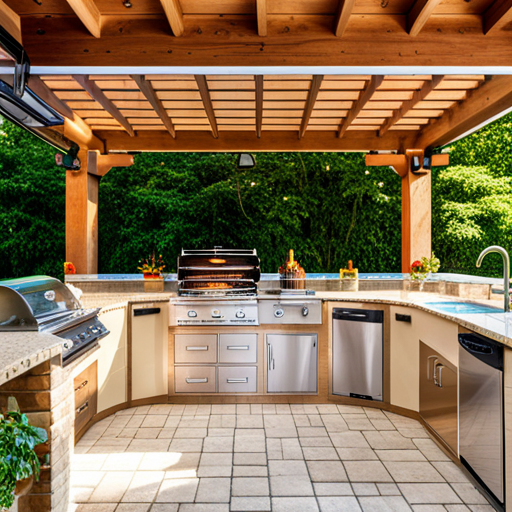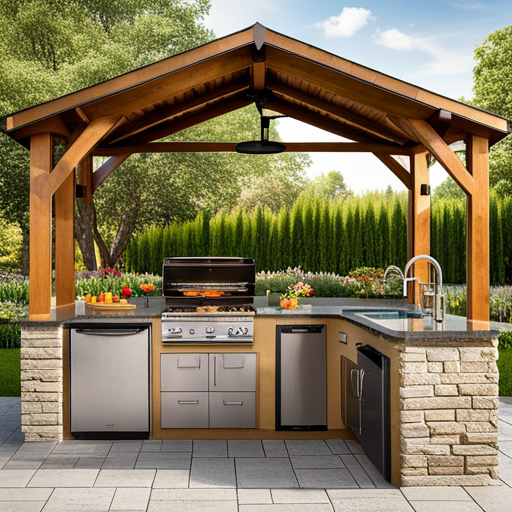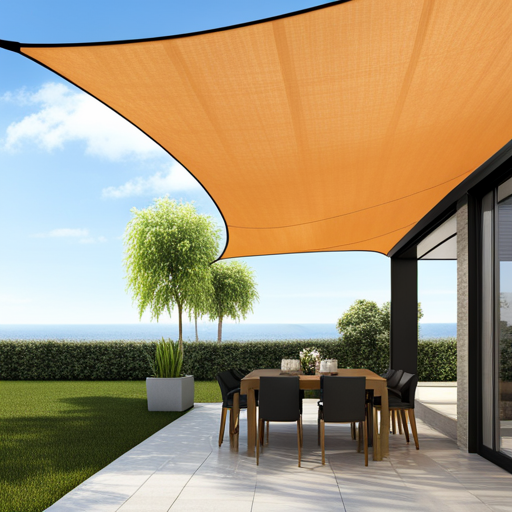Last Updated on June 19, 2024 by John Coleman
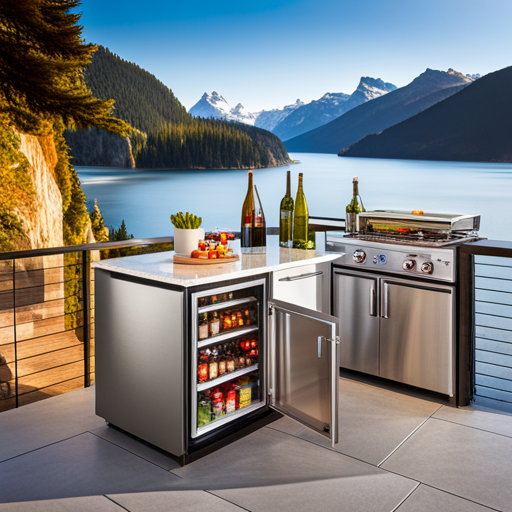
Introduction
Picture this: You’re hosting an epic backyard barbecue, enjoying the sunshine. As you prepare delicious food and pour refreshing drinks, you realize the convenience of having an outdoor fridge at your fingertips. In this guide, discover the world of outdoor fridges. We’ll provide the essential knowledge for making an informed decision when purchasing one. Elevate your outdoor entertaining game!
If you purchase through links on this site, we may earn a small commission. See our affiliate disclosure.
Why do I need an outdoor fridge?
An outdoor fridge offers numerous benefits for homeowners and outdoor enthusiasts alike. It provides convenient access to chilled beverages, snacks, and ingredients without the need to constantly go back inside. Additionally, it frees up space in your indoor refrigerator, allowing you to store more items for outdoor entertaining.
What is the difference between an outdoor fridge and an indoor fridge?
While both indoor and outdoor fridges serve the same purpose of keeping your food and drinks cold, there are crucial distinctions to consider. Outdoor fridges are built to withstand various weather conditions, including extreme temperatures, rain, and humidity. They are designed to be more durable, have better insulation, and feature weather-resistant exteriors. Furthermore, outdoor fridges are built to operate at higher temperatures, making them more energy-efficient and cost-saving.
How much do outdoor fridges cost?
The cost of an outdoor fridge varies depending on its size, features, and brand. On average, you can expect to spend anywhere from $500 to $3000 for a high-quality outdoor fridge. It’s important to keep in mind that investing in a durable and reliable outdoor fridge will pay off in the long run, as it will have a longer lifespan and save you money on energy bills.
Types of Outdoor Fridges
Built-in: These fridges are designed to be installed into existing outdoor kitchen cabinetry and have a sleek, seamless look. They are typically larger and offer more storage capacity.
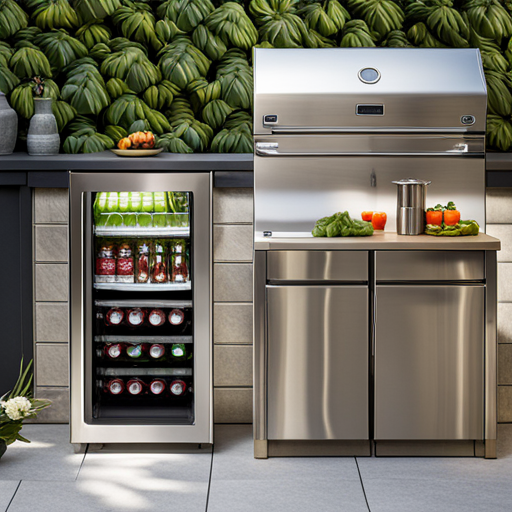
Freestanding: As the name suggests, these fridges can stand on their own without being built into any cabinetry. They are smaller in size and easier to move around, making them a great option for those who don’t have a designated outdoor kitchen area.
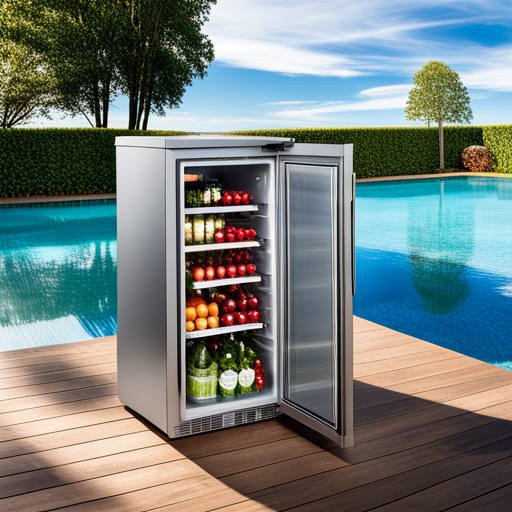
Outdoor Fridge Categories
Traditional Outdoor Fridges
- Compact Outdoor Fridges: These are small, portable, and perfect for small patios or for those who only need to store a few items. They are the most affordable option but offer limited storage capacity.
- Outdoor Drawer Fridges: These fridges have drawers instead of doors, allowing for easy access and efficient organization of food and drinks. They are perfect for built-in installations or under-the-counter setups.
- Full-Size Outdoor Fridges: These fridges are similar in size to standard indoor fridges and offer ample storage space. They are perfect for those who often host large outdoor gatherings or families that enjoy outdoor cooking.
Outdoor Coolers
- Outdoor Beverage Coolers: These are designed specifically for cooling beverages. They come with racks designed to hold cans and bottles, making it easy to organize and access your drinks.
- Outdoor Wine Coolers: These are built with features that preserve and enhance the quality of stored wine, such as stable temperature controls and UV-protected glass doors.
Outdoor Freezers
- Compact outdoor freezers: Smaller in size and often designed for specific purposes like storing beverages or small amounts of frozen food. They are portable and versatile.
- Upright Freezers: These are ideal for those who have limited space in their outdoor kitchen area. They are taller and slimmer than traditional freezers and can fit easily in small spaces.
- Dual-Zone Freezers: Some outdoor freezers offer dual-zone capabilities, allowing you to set different temperature zones within the same unit. This is useful for storing items that require different freezing temperatures.
- Chest Freezers: These are larger and designed for those who need to store large amounts of frozen food or items like bulk meat or fish. They offer more storage capacity but take up more floor space.
- Solar-Powered Freezers: Designed for off-grid or environmentally conscious users, these freezers are powered by solar energy, making them suitable for remote outdoor locations.
What to look for when choosing an outdoor fridge
- Size and Capacity: Consider the amount of space you have available for the fridge, as well as how much storage you need for your food items and drinks. The typical sizes range from 1.7 cubic feet to 6 cubic feet. The typical dimensions of an outdoor fridge are 24 inches wide, 34 inches high, and 24 inches deep. Of course, these dimensions do not apply to “full-size” outdoor models.
- Temperature Control: Look for fridges that have adjustable temperature control so you can keep your items at the desired temperature, depending on what you are storing. Some models have digital thermostats, while others have knobs that you can turn to adjust the temperature.
- Weather resistant/Durability: As mentioned earlier, outdoor fridges need to withstand various weather conditions. Look for models that are made with durable materials and have good insulation to ensure your fridge lasts for years. Outdoor fridges are typically made with stainless steel (304-grade commonly) or weather-resistant materials such as marine-grade polymer. These materials are rust-resistant and can handle exposure to harsh elements.
- Energy Efficiency: Outdoor fridges that operate at higher temperatures tend to be more energy-efficient, helping you save on electricity costs. Look for models with Energy Star ratings or ones that use LED lighting, which consumes less power than traditional bulbs.
- Mobility: Consider whether you want a fridge that can be easily moved around or one that is permanently installed in a specific spot. Some models come with wheels or casters, making it easier to move them around when needed.
- Noise Level: If your outdoor living space is close to your neighbors or you simply prefer a quieter environment, consider the noise level of the fridge. Look for models with lower decibel ratings, which indicate how loud the fridge will be when running.
- Design: You will want the fridge to complement your outdoor space, so consider the design and color options available. Some models have a sleek stainless steel finish that fits well with modern designs, while others have a more traditional look.
- Shelving Options: Some outdoor fridges come with adjustable or customizable shelving options, allowing you to store various types of food and drinks easily. This is especially useful for those who entertain frequently and need to accommodate different sizes of items.
- Security Locks: If you have small children or want to keep your fridge secure, look for models with security locks. This will prevent unauthorized access and ensure the safety of your food and drinks.
- Price: Finally, compare different models and prices to ensure you are getting a good deal. Remember, the most expensive option is not always the best. It’s about finding the right balance of cost and features.
- Warranty: As outdoor fridges are often exposed to extreme weather conditions, it’s important to consider warranties when purchasing. Look for models with long-term warranties that cover parts and labor and rust and corrosion protection.
- Maintenance: Like any appliance, outdoor fridges require regular maintenance to keep them in good working condition. Look for models with easy-to-clean surfaces and removable shelves or drawers for easier cleaning.
Maintenance tips for outdoor fridges
To keep your outdoor fridge in optimal condition, follow best practices such as regular cleaning, checking and replacing filters, and inspecting the gasket for a proper seal. Additionally, consider covering your fridge during extended periods of non-use to protect it from debris and weather conditions.
Conclusion
Investing in an outdoor fridge can truly elevate your outdoor entertaining experience, providing you with unparalleled convenience. By carefully considering factors such as durability, size, features, and maintenance, you can discover the ideal outdoor fridge that not only caters to your needs but also withstands the elements gracefully. Through meticulous research and thoughtful consideration, you’ll be well on your way to crafting the perfect outdoor oasis, where culinary delights and refreshing beverages harmoniously blend. Here’s to embracing the joys of outdoor living!
Frequently Asked Questions
Q: Are outdoor fridges easy to install?
A: Yes, most outdoor fridges are designed for easy installation and can be set up in just a few simple steps.
Q: Do outdoor fridges have a certain power requirement?
A: Outdoor fridges generally have a standard power outlet requirement. This information should be pretty easy to find in the product details.
Q: Can you leave an outdoor fridge outside year-round?
A: Yes, as long as you have chosen a fridge that is specifically designed for outdoor use and can withstand the elements.
Q: What is the average lifespan of an outdoor fridge, and are there signs that it may need replacement or repairs?
A: The average lifespan of an outdoor fridge can vary depending on usage and maintenance, but it is generally expected to last at least 5-10 years. Signs that your fridge may need replacement or repairs include a decrease in cooling efficiency, strange noises, and visible damage. It’s important to regularly check and maintain your fridge to ensure its longevity and optimal performance.
Q: Can outdoor fridges be used in covered or enclosed spaces, or are they strictly for open-air environments?
A: Some outdoor fridges may be suitable for use in covered or enclosed spaces, but it’s important to check the product details and manufacturer’s recommendations. Using an outdoor fridge in a well-ventilated open-air environment is generally safer to prevent overheating.
Q: Is there any special care required for outdoor fridges during colder months?
A: Yes, if you live in an area with colder temperatures, it’s important to properly winterize your outdoor fridge before the freezing weather sets in. This may include draining and cleaning the fridge, disconnecting water lines, and covering or storing the fridge in a protected area. It’s also recommended to keep the fridge at a slightly warmer temperature during winter months to prevent damage to the compressor and other components.
Q: How do I clean my outdoor fridge?
A: To clean an outdoor fridge, unplug it and remove all contents. Then wipe down the interior with a mixture of warm water and mild soap. Rinse thoroughly and dry with a clean cloth. For tougher stains, use a non-abrasive cleaner specifically designed for fridges. Don’t forget to also clean the exterior and any removable parts like shelves or drawers. Regular cleaning can help prevent mold and bacteria growth and maintain the overall appearance of your fridge.
If you liked this article, you may also like:
How to Choose a Grill for Your Outdoor Kitchen: The Ultimate Buying Guide
A Guide to Design a Low-Budget DIY Outdoor Kitchen
Sizzle and Vent: How to Select the Perfect Outdoor Range Hood for Your BBQ Haven
If you purchase through links on this site, we may earn a small commission. See our affiliate disclosure.


